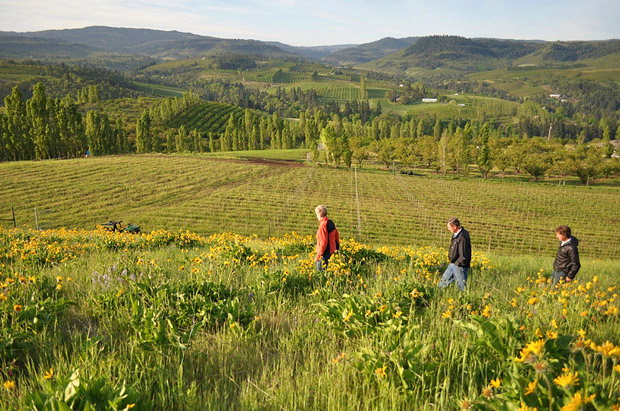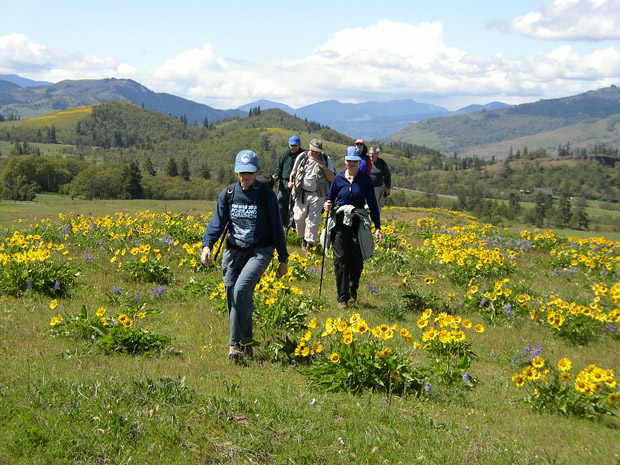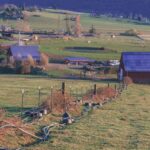Travelers have always come to Oregon for its natural beauty. But will the increasing popularity of agritourism, European-style hiking getaways and forest resorts relax Oregon’s notoriously strict land-use laws?
Green springs Inn & Cabins, 18 miles southeast of Ashland, is a singular place. A portion of the 150-acre property — which includes an eight-room main lodge and nine rustic cabins — lies inside the sprawling Cascade-Siskiyou National Monument. All nine solar-powered cabins are made from felled trees that were on the land when owner Diarmuid McGuire bought 145 acres from Boise Cascade in 2003. The property attracts all sorts — eco-travelers from Europe, Microsoft and Facebook employees, and Pacific Crest Trail hikers looking for their next meal. “People who want to be in the forest but not feel like they’re damaging it,” says owner Diarmuid McGuire.
The property is appealing precisely because of its setting on the edge of a vast wilderness; the 87,000-acre Cascade-Siskiyou forest has one of the most biodiverse ecosystems in the Cascade Range, with rare alpine meadows, 120 butterfly species, 200 bird species, and several dozen endangered animal species including the willow flycatcher and the northern spotted owl. In fact, Green Springs Inn is located on “resource land”— in this case, forestland that is protected from development under Oregon’s pioneering land- use laws. (McGuire was allowed to build nine cabins on this land due to a provision in the law that allows seasonal hunting and fishing cabins.)
“We’re in one of the last great boreal forests on the planet!” McGuire says, his voice swelling with pride. “The forest has been abused by human activity, but we’re seeing the trend slowly reversing itself. But people need to understand it to support it.”
In order to do this, McGuire dreams of building an interpretive center on his property that would teach visitors about the Cascade-Siskiyou ecosystem and why it’s so important to preserve. He’d also like to build an additional 30 or 40 cabins, some of which he could sell off to finance the project. But he can’t do that because Oregon’s landmark land-use law forbids it. Passed in 1973, the Oregon Land Conservation and Development Act protects so-called resource land — land zoned as forest or agriculture.
“This legislation is what makes Oregon worth living in,” concedes McGuire. “But on the other hand, if you want to run a business on resource land, you have to deal with a set of pretty strict rules.” An amendment added in 1984 (“Goal 8”) allowed large destination resorts — places like Sunriver and Running Y Ranch — on resource land. “Most of these are gated rural communities with golf courses and some visitor accommodations,” says McGuire. (See “Destination Resorts 2.0,” page 56) But oddly, that amendment still forbade small-scale resorts, projects like Green Springs Inn, with a relatively small environmental footprint.
Which is why McGuire, with the support of Rep. Peter Buckley (D-Ashland), is drafting an amendment that would tweak the law, allowing small destination resorts with educational facilities and low-impact recreational activities (hiking, birding, fishing, etc.) to open on resource land. “Both of those things gave us a lot of heartburn,” says Greg Holmes, Southern Oregon planning advocate for 1,000 Friends of Oregon. It would’ve opened up some of the worst outcomes that have come about under the large-scale resort amendment, Goal 8. So for the time being, McGuire is putting the legislation on hold and instead trying to get approval for his project at the county level. But even if the Jackson County supervisors grant him a permit to build on resource land, that decision could be shot down by a community member.
“Any citizen with $500 can appeal that decision to the Land Use Board of Appeals,” says McGuire. “And I cannot afford to fight an appeal.” If that happens, McGuire says he would rewrite the amendment, hopefully gaining 1,000 Friends’ buy-in, and ask Buckley to back it in the 2016 legislative session.

Green Springs Inn owner Diarmuid McGuire wants to build more cabins on his forest zoned property.
McGuire’s vision to allow small eco-resorts on protected land is one of several early-stage efforts that suggest a movement is afoot to relax Oregon’s famously strict land-use laws. Tension has always existed between environmentalists and pro-business interests in the state, and nowhere is that more apparent than in the tourism sector. As written, the 1973 law forbids small destination resorts on resource land and makes it difficult (but not impossible) for working farms to host overnight guests.
“This legislation is what makes Oregon worth living in. But if you want to run a business on resource land, you have to deal with pretty strict rules.”
But as more tourists visit the state to discover its untrammeled rural beauty — from horseback riding in wine country to agritourism in the Gorge — business owners like McGuire are eager to oblige. Farmers are opening farm stays that include breakfast, outfitters are taking cyclists and horseback riders on agritourism-themed excursions, and nonprofits are forging European-style networks of hiking trails that merge public land with private enterprise — all while having minimal impact on local environments. Oregon’s land use law 2.0 may be a boon not only for ecotourism operators but for the environment as well.
That’s what the visionaries behind “Gorge Towns to Trails” are hoping, anyway. Launched three years ago by the nonprofit Friends of the Columbia Gorge, Towns to Trails seeks to develop a 300-mile trail that wraps around the Gorge, linking small towns and communities with wineries, breweries and secluded natural areas. Project manager Renee Tkach says the idea is modeled on European hiking tours, which allow travelers to hike from winery to winery (or pub to pub), spending the night along the way — sometimes at a winery or farm — while an outfitter delivers your bags.
“This program would’ve been a crazy idea 28 years ago, because there wouldn’t have been any connections between the towns,” explains Tkach. But over the past 28 years, the U.S. Forest Service has snapped up more than 40,000 acres of land, protecting it from development but also making it easier to build trails between towns. Friends of the Columbia Gorge also has a land trust through which they’ve already purchased over 1,000 acres of land. (The Land Trust is actively working with area land owners who are interested in easements and may purchase more private land as it becomes available.)
Originally, Friends of the Columbia Gorge thought the trail would live only on public land. But Tkach says that Gorge-area businesses — especially wineries and other agritourism ventures —have been so supportive of the concept of a European-style trail network that traverses both public and private land that the Land Trust may not need to purchase all the remaining private land.
“There’s a winery in Mosier called Analemma, and the owner, Kris Fade, was saying, ‘I want a trail that goes right through my vineyard, just like in Tuscany — private land but with a permit,’” recounts Tkach.
Though the entire 300-mile loop is a few decades off, certain segments are near completion. The Hood River to The Dalles corridor is 78% completed, says Tkach, and the Washougal to Stevenson section is 80% completed. When it’s finished, the Hood River-Dalles trail will be a three-to- five day experience with hikes of 10 to 12 miles a day. Tkach guesses that the entire 300-mile loop could be a two-week hiking trip.
Gorge Towns to Trail already offers “Trails to Ales” day hikes that end at a brewery and “wiking” trips that send hikers off with a wine tasting. But this spring, as a preview of future longer trips, they began offering overnights under the category of “Play & Stay.” In April they ran a “Blooms & Brews” trip that took guests on a private tour of gallery Lorang Fine Art in Cascade Locks, followed by dinner and pints at Thunder Island Brewing, an overnight at the Best Western and a morning hike at Dry Creek Falls. A few Gorge wineries may soon add yurts for farm stays, but for now, Airbnb seems to be filling in the lodging gaps, especially in towns like Mosier that don’t have hotels.

Tuscany on the Willamette: Hiking through the Analemma winery, Mosier
Nowhere is the cross-pollination of low-impact recreation and agritourism more apparent than in the wine industry. Wine-related tourism has always contributed a lot to the state’s economy: $207.5 million in 2013. Though the Oregon Wine Board doesn’t track economic impact by types of wine tours, outfitters say interest in their cycling, horseback riding and “wiking” (hiking and wine tasting) trips has never been higher.
“A winery in Mosier was saying, ‘I want a trail that goes right through my vineyard, just like in Tuscany: private land but with a permit.”
“In the last two years, our Wine Country trip has really taken off as one of our bigger tours,” says Pedal Bike Tours’ marketing director Lota LaMontagne. Guests bike a 12-mile loop down backcountry lanes and stop at three wineries: Adelsheim, Bergström and Four Graces.
Lindley and Justin Leahy of Willamette Coast Ride run a six-day, intermediate- level horseback-riding trip that takes riders from wine country through the Siuslaw National Forest and on to the Oregon Coast. It ends with a wine tasting at WillaKenzie Estate in Yamhill. Though they just moved to Oregon last year, their trips have been a hit with equestrians from both the U.S. and abroad. (Justin, whose father is noted equestrian Willie Leahy from Ireland’s Connemara Trail, grew up riding and training Connemara horses.)
“One of the obstacles with horseback riding are the liability issues,” says Lindley. “The folks at WillaKenzie welcomed us and are very open minded and friendly to both tourism and local businesses.” Lindley says these trips are also a low-impact way for travelers to see the Siuslaw National Forest up close. “Although we’re in federally owned land a lot of the time, there are different privately-owned pieces that are clear-cut, so you get to see a little bit of everything,” she says.
Over in Bend, James Jaggard from Wanderlust Tours retrieves tourists at motels and drives them to vineyards, breweries and cideries, where they can either hike or canoe off to the next site. These tours are popular with both retirees and college students, he says. “They love that our guides can interpret the natural and cultural history here,” says Jaggard. “Sipping local wines and craft beers is the icing on the cake.”
Agritourism, it turns out, is a growing part of Oregon’s tourism economy — and not just at wineries. “Staying on a winery, hazelnut farm or hop farm is such a cool, unique, original Oregon experience,” says Harry Dalgaard, destination development specialist at Travel Oregon. Despite land-use restrictions and liability issues, Dalgaard has seen a surge in the number of farm and ranch stays over the last few years, and a “relative explosion” of tours to farms and ranches. Travel Oregon is so confident about the potential of agritourism that the agency convened a statewide working group last year to more comprehensively develop and promote agritourism.
Some counties are more lenient than others when it comes to allowing visitors on a working farm. Lucky for Scottie Jones, the owner of the perennially booked Leaping Lamb Farm Stay in Alsea (35 miles southwest of Corvallis), the Benton county planner she worked with in 2006 was open to the idea. She approved Jones’ application for a two-bedroom cottage even though her land was zoned exclusively for farm use (EFU). Jones had to notify her neighbors of this change, but they gave their blessing too.
Jones, who is a member of Travel Oregon’s agritourism working group, sees farm stays as an essential way of maintaining farmland. “You don’t lose farmland if you allow small farms to diversify into agritourism,” she says. Her story proves her point. New farmers in 2003, Jones and her husband, Greg, learned the hard way that lambs alone would not pay for the farm. After a few years, they were only grossing $5,000 annually.
“Our retirement was financing the farm,” Jones says, noting that you can’t graze more than 40 lambs on 20 acres of pasture. “The economies of scale just aren’t there for small farms.” Now, with just one on-farm cottage (it goes for $250 a night in summer), Jones is grossing $35,000-$40,000 a year. Sixty percent of her guests come from Portland, with the rest hailing mostly from Seattle, San Francisco and Los Angeles. In the summer, she gets lots of European visitors, who are more familiar with the concept of farm stays, she says. Jones was spending so much time referring would-be guests to other farm stays (because Leaping Lamb was all booked up) that she launched Farm Stays U.S., a promotional website for American farm stays. So far there are 800 listings, with 32 in Oregon.
The other hurdle agritourism-minded farmers face is liability insurance. Because of the inherent risks of being on a farm (think dangerous farming equipment, slippery mud and temperamental animals), only one company in the state has insured farmers until now, says Ivan Maluski, director of Friends of Family Farmers. But Senate Bill 341, which at press time had just passed unanimously in the Oregon Senate and was headed for the House, will hopefully change that by limiting a farmer’s liability when members of the public visit for U-pick, pumpkin patches or farm stays. “The hope is that the bill will lower the risk of farmers getting sued and create an opportunity — a regulatory environment where more companies will consider insuring farmers,” explains Maluski.

Hill walking in the Columbia Gorge
Once liability issues and land-use restrictions are tackled, Dalgaard predicts we’ll soon see a veritable explosion of agritourism across the state. In some cases, entrepreneurs are creating an agritourism infrastructure in rural areas that haven’t had any tourism at all until now. Last fall 33-year-old James Good opened Good Bike Co. in Prineville — 50- miles northeast of Bend. Located at the crosshairs of the TransAmerica Bicycle Trail and The Oregon Outback, a 360-mile “bikepacking route,” the shop has done a brisk business catering to cyclists of all sorts. But when Good began connecting with local farmers and ranchers, he realized there was an untapped opportunity.
“You don’t lose farmland if you allow small farms to diversify into agritourism.”
“I thought, ‘That’d be a perfect match, to integrate cycling with farm-to-table,’” says Good, who was inspired by a recent cycling trip he and his wife took in Scotland. This summer he’s offering day-long bike trips to a nearby lavender farm, a dairy farm, a biodynamic vegetable farm, a working cattle ranch and a family-run cheesemaking operation. He also runs custom tours to the Willamette Valley, schlepping guests’ gear so they can ride from winery to B&B unencumbered.
McGuire, from Green Springs Ranch near Ashland, is encouraged by all of these developments in rural areas. And he’s well aware that the very reason Oregon farms are still intact — and so appealing to visitors — is because sprawl is contained. “Farms are being subdivided in every single state of the union except for Oregon,” says McGuire. “That’s why I would defend Oregon to the death!” But McGuire dares to dream for a balance that’s so far been elusive. “I’m thinking if we can write a real bill — something that the environmentalists and the people concerned about the economy could agree on — that would be a hot ticket.”




